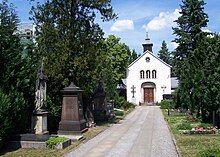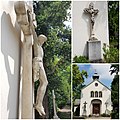
The Vienna Central Cemetery is one of the largest cemeteries in the world by number of interred, and is the most well-known cemetery among Vienna's nearly 50 cemeteries. The cemetery's name is descriptive of its significance as Vienna's biggest cemetery, not of its geographic location, as it is not in the city center of the Austrian capital, but on the southern outskirts, in the outer city district of Simmering.

The Non-Catholic Cemetery, also referred to as the Protestant Cemetery or the English Cemetery, is a private cemetery in the rione of Testaccio in Rome. It is near Porta San Paolo and adjacent to the Pyramid of Cestius, a small-scale Egyptian-style pyramid built between 18 and 12 BCE as a tomb and later incorporated into the section of the Aurelian Walls that borders the cemetery. It has Mediterranean cypress, pomegranate and other trees, and a grassy meadow. It is the final resting place of non-Catholics including but not exclusive to Protestants or British people. The earliest known burial is that of a Dr Arthur, a Protestant medical doctor hailing from Edinburgh, in 1716. The English poets John Keats and Percy Bysshe Shelley, as well as Russian painter Karl Briullov and Italian Marxist Antonio Gramsci are buried there.

St. Marx Cemetery is a cemetery in the Landstraße district of Vienna, used from 1784 until 1874. It contains the unmarked grave of the famous composer Wolfgang Amadeus Mozart.

Dresden Cathedral, or the Cathedral of the Holy Trinity, Dresden, previously the Catholic Church of the Royal Court of Saxony, called in German Katholische Hofkirche and since 1980 also known as Kathedrale Sanctissimae Trinitatis, is the Catholic Cathedral of Dresden.
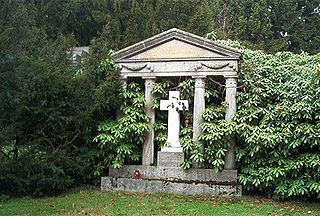
Ohlsdorf Cemetery in the Ohlsdorf quarter of the city of Hamburg, Germany, is the biggest rural cemetery in the world and the fourth-largest cemetery in the world. Most of the people buried at the cemetery are civilians, but there is also a large number of victims of war from various nations. The cemetery notably includes the Old Hamburg Memorial Cemetery with the graves of many notable Hamburg citizens.

The Alter Südfriedhof also known as "Alter Südlicher Friedhof" is a cemetery in Munich, Germany. It was founded by Duke Albrecht V as a plague cemetery in 1563 about half a kilometer south of the Sendlinger Gate between Thalkirchner and Pestalozzistraße.

Jerusalem Church is one of the churches of the Evangelical Congregation in the Friedrichstadt, a member of the Protestant umbrella organisation Evangelical Church of Berlin-Brandenburg-Silesian Upper Lusatia. The present church building is located in Berlin, borough Friedrichshain-Kreuzberg, in the quarter of Friedrichstadt. Jerusalem Church is fourth in rank of the oldest oratories in the town proper.

The Petersfriedhof or St. Peter's Cemetery is – together with the burial site at Nonnberg Abbey – the oldest cemetery in the Austrian city of Salzburg, located at the foot of the Festungsberg with Hohensalzburg Castle. It is one of Salzburg's most popular tourist attractions.

The Dorotheenstadt Cemetery, officially the Cemetery of the Dorotheenstadt and Friedrichswerder Parishes, is a landmarked Protestant burial ground located in the Berlin district of Mitte which dates to the late 18th century. The entrance to the 1.7-hectare (4.2-acre) plot is at 126 Chaussee Straße. It is also directly adjacent to the French cemetery, established in 1780, and is sometimes confused with it.
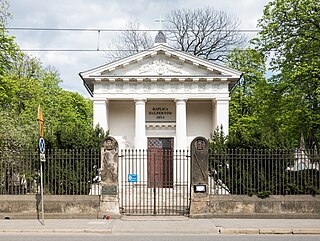
The Evangelical–Augsburg Cemetery, is a historic Lutheran Protestant necropolis located in the western Wola district of Warsaw, Poland.

Matzleinsdorf Protestant Cemetery is a historic church-owned and operated Protestant cemetery located in the Favoriten district of Vienna, the capital city of Austria.

The Protestant Kaiser Wilhelm Memorial Cemetery is a burial ground in the Westend district of Berlin with a size of 3.7 hectares. The cemetery is under monument and cultural heritage protection.

Alter Friedhof is a historically significant cemetery in Bonn, Germany, 1.2 hectares in area, located near the center of the modern city.

The Hauptfriedhof in Karlsruhe is one of the oldest German communal rural cemeteries. In 1871, the first plans to build a new burial ground outside the city center began. The cemetery was laid out in 1874 by Josef Durm in the Rintheim district, east of the actual city, after the inner-city Alter Friedhof Karlsruhe in the Oststadt had become too small. The main cemetery has grown from its original size of 15.3 hectares in 1873 to over 34 hectares. The graves of more than 32,000 deceased are currently in the cemetery.
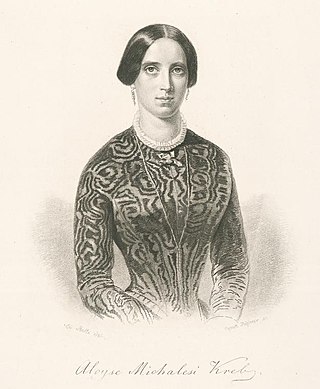
Aloyse Michalesi, married name Aloyse Krebs-Michalesi, also Aloysia Krebs-Michalesi was a German operatic contralto.

Karl August Krebs, also Carl, Miedtke, was a German pianist, composer, conductor and Kapellmeister.
Mary Krebs-Brenning was a German woman pianist.

The Stahnsdorf South-Western Cemetery is a Protestant rural cemetery in Germany. Established in 1909, the cemetery is located in the municipality of Stahnsdorf in Potsdam-Mittelmark district, Berlin/Brandenburg Metropolitan Region. With a land area of approximately 206 ha, it is the largest church-owned Christian cemetery in Germany, as well as being the tenth largest cemetery in the world and Germany's second largest cemetery after Hamburg's Ohlsdorf Cemetery. The cemetery is operated by the administration of the Berlin City Protestant Synod Association. Due to its status as one of the most important landscape parks in the Berlin metropolitan area, along with the large amount of historically valuable tombs and other buildings which include the landmark wooden chapel, the cemetery was designated as a place of special importance and a protected area by the state of Brandenburg in 1982.

The Frauenkirchhof was the oldest known cemetery in Dresden. It had existed since the first building of the Frauenkirche, which is dated to the 10th or 11th century. Until the 16th century, the Frauenkirchhof was the main burial place for the inhabitants of Dresden, who often buried their dead in the cemetery for several generations due to large family graves. The richly decorated and painted Schwibbogengräber were of particular art-historical value. Due to new buildings at the Frauenkirche, the cemetery was initially reduced in size several times and finally secularized by 1727 despite protests from the population in the course of the construction of the new Frauenkirche built by George Bähr. Epitaphs and gravestones have been preserved from the cemetery. Archaeological excavations since the 1980s have unearthed grave goods, including several funeral crowns.
